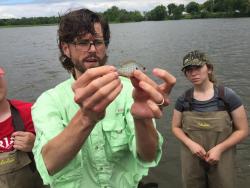The John J. Brander and Christine E. Rundblad Research Fellowship Program at the Milwaukee Public Museum seeks to stimulate fundamental research by scientists doing research on Wisconsin biodiversity or environmental issues, especially those that utilize and strengthen the natural science collections at MPM.
 Todd Levine, PhD
Todd Levine, PhD
Lecturer in Biology, Department of Life Sciences, Carroll University, Waukesha, WI
Research: Mussels are an essential part of the freshwater community. Freshwater communities are among the rarest and most valuable ecosystems on the Earth. Mussels are strongly affected by the water body and watershed in which they live and are good indicators of water quality and ecosystem function. Dr. Levine hopes to gain an understanding of changes in mussel communities as prairie and forests lands are converted to agriculture or are urbanized.
 Jessica Orlofske, Ph.D
Jessica Orlofske, Ph.D
Assistant Professor, Biological Sciences Department, University of Wisconsin-Parkside, Kenosha, WI
Research: Aquatic systems are some of the most stressed and threatened environments on earth and demonstrate a need for research and management. Research has shown that aquatic insects are sensitive to environmental disturbances and can provide evidence of ecosystem health. Wisconsin is host to a number of species of dragonflies, including several threatened and endangered state and federally listed species. Dr. Orlofske hopes to determine the species composition of emerging riverine dragonfly assemblages in relation to habitat characteristics from sites in northern Wisconsin.
 Michael Pauers, PhD
Michael Pauers, PhD
Assistant Professor, Department of Zoology, University of Wisconsin-Waukesha, Waukesha, WI
Research: The Orange-spotted Sunfish is a member of the family that contains sunfishes and basses – game fish that are often managed by the state. Understanding geographic variation within a species as it related to basic biology helps us to understand how to manage each species. Dr. Pauers will be attempting to find the origin of the population of sunfish that was used to stock Lake Belle View. The lake was drained for dam reconstruction in 2015 and the population was extirpated. That population has different sized scales than other populations and Dr. Pauers would like to find the source populations to understand its biology and natural history.

